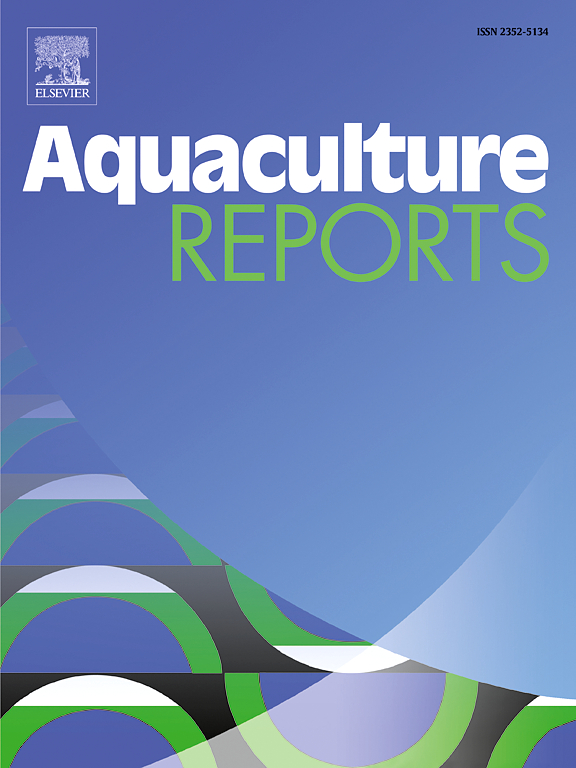Effects of β-1,3-glucan feed supplementation on the growth, liver biochemistry, transcript levels and intestinal microorganisms of swamp eel (Monopterus albus)
IF 3.2
2区 农林科学
Q1 FISHERIES
引用次数: 0
Abstract
This study investigated the effects of β-1,3-glucan feed supplementation on the growth, liver biochemistry, transcript levels, and intestinal microbiome of Monopterus albus. The experiment involved five groups: 0 % (CT), 0.2 % curdlan (EG-1), 0.1 % β-1,3-glucan (EG-2), 0.2 % β-1,3-glucan (EG-3), and 0.5 % β-1,3-glucan (EG-4). Monopterus albus were reared for 56 days, the final body weight, weight gain rate, survival rate, and specific growth rate were significantly increased, while the feed conversion rate was reduced considerably, in EG-2, EG-3, and EG-4 compared with the CT (P < 0.05). The addition of β-1,3-glucan significantly reduced the malondialdehyde content (P < 0.05), and significantly increased the activities of superoxide dismutase, catalase, and glutathione peroxidase in the liver (P < 0.05). This indicated that β-1,3-glucan can effectively promote the growth and antioxidant capacity of M. albus. The results of liver tissue sections showed that β-1,3-glucan effectively reduced lipid accumulation in the liver. Transcriptome sequencing revealed that differentially expressed genes were significantly enriched in the peroxisome proliferator-activated receptor signaling pathway, indicating that β-1,3-glucan can regulate liver metabolic functions of M. albus. In addition, intestinal microbial assays showed that dietary β-1,3-glucan decreased intestinal microbial abundance and diversity. These results suggest that the β-1,3-glucan used in this study may reduce microbial abundance and diversity, potentially through the inhibition of certain harmful bacterial species. Furthermore, it increased the relative abundance of the beneficial bacteria Shewanella xiamenensis and the Lachnospiraceae NK4A136 group, which can alter intestinal microbial composition and maintain intestinal health. In summary, these results further elucidate the effects of β-1,3-glucan on the growth, liver antioxidant function and lipid metabolism, and intestinal microorganisms of M. albus. They can facilitate molecular mechanism analysis for the research and development of aquafeed functional additives, which is of great importance for the promotion of green and sustainable aquaculture.
饲粮中添加β-1,3-葡聚糖对黄鳝生长、肝脏生化、转录产物水平和肠道微生物的影响
本试验研究了饲粮中添加β-1,3-葡聚糖对黄鳝生长、肝脏生化、转录产物水平和肠道微生物群的影响。实验分为5组:0 % (CT)、0.2 %凝乳素(EG-1)、0.1 % β-1,3-葡聚糖(EG-2)、0.2 % β-1,3-葡聚糖(EG-3)、0.5 % β-1,3-葡聚糖(EG-4)。饲养56 d后,与对照组相比,EG-2、EG-3和EG-4组的末重、增重率、成活率和特定生长率显著提高,饲料转化率显著降低(P <; 0.05)。添加β-1,3-葡聚糖显著降低了肝脏丙二醛含量(P <; 0.05),显著提高了肝脏超氧化物歧化酶、过氧化氢酶和谷胱甘肽过氧化物酶活性(P <; 0.05)。说明β-1,3-葡聚糖能有效促进白僵菌的生长和抗氧化能力。肝组织切片结果显示,β-1,3-葡聚糖可有效降低肝脏脂质积累。转录组测序结果显示,过氧化物酶体增殖物激活受体信号通路中差异表达基因显著富集,表明β-1,3-葡聚糖可调节白螺旋体肝脏代谢功能。此外,肠道微生物分析显示,饲粮中添加β-1,3-葡聚糖降低了肠道微生物的丰度和多样性。这些结果表明,本研究中使用的β-1,3-葡聚糖可能通过抑制某些有害细菌物种来降低微生物的丰度和多样性。此外,它还增加了厦门希瓦氏菌和毛缕菌科NK4A136群有益菌的相对丰度,改变肠道微生物组成,维持肠道健康。综上所述,这些结果进一步阐明了β-1,3-葡聚糖对白螺旋体生长、肝脏抗氧化功能和脂质代谢以及肠道微生物的影响。它们可以为水产饲料功能添加剂的研究和开发提供分子机理分析,对促进绿色和可持续水产养殖具有重要意义。
本文章由计算机程序翻译,如有差异,请以英文原文为准。
求助全文
约1分钟内获得全文
求助全文
来源期刊

Aquaculture Reports
Agricultural and Biological Sciences-Animal Science and Zoology
CiteScore
5.90
自引率
8.10%
发文量
469
审稿时长
77 days
期刊介绍:
Aquaculture Reports will publish original research papers and reviews documenting outstanding science with a regional context and focus, answering the need for high quality information on novel species, systems and regions in emerging areas of aquaculture research and development, such as integrated multi-trophic aquaculture, urban aquaculture, ornamental, unfed aquaculture, offshore aquaculture and others. Papers having industry research as priority and encompassing product development research or current industry practice are encouraged.
 求助内容:
求助内容: 应助结果提醒方式:
应助结果提醒方式:


